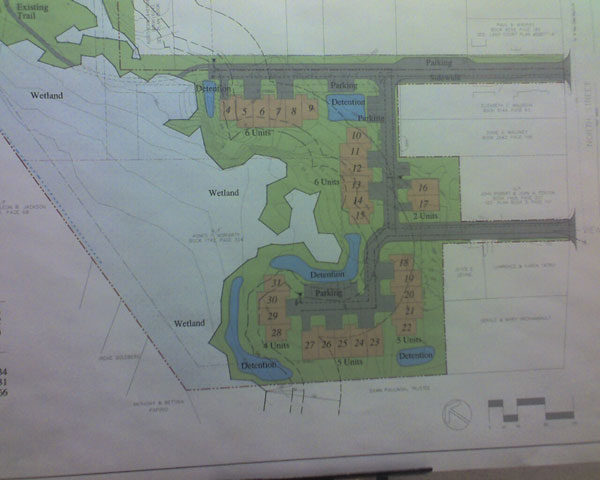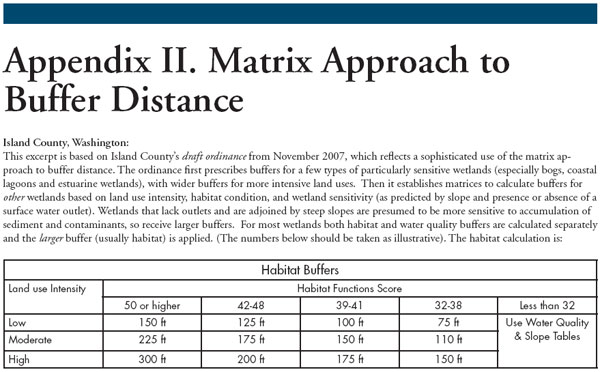The Environmental Law Institute has just made available a Planner’s Guide to Wetland Buffers for Local Governments as a free 25-page PDF download. This survey of today’s buffer management regimes holds several lessons for Northampton. Among them, the 10-foot buffer zones in our new Wetlands Ordinance are extremely narrow. Buffer zones in ELI’s survey range from 15 feet to approximately 350 feet. Some locales require extra setbacks for structures. Most striking is that some locales desire wider buffers in areas of intense land use to address the higher levels of pollution and runoff. By contrast, Northampton has its narrowest buffers in these areas.
Planner’s Guide to Wetland Buffers for Local Governments
Environmental Law Institute, March 2008[emphasis added]
…This guide for planners is based on detailed examination
of approximately 50 enacted wetland buffer
ordinances and nine model ordinances, and upon several
hundred scientific studies and analyses of buffer
performance. This guide identifies both the state-of-the-art and the range of current practice in the protection
of wetland buffers by local governments…City of Boulder, 2007
Wetland buffers in urban areas are particularly important in helping to moderate the impacts of altered hydrologic regimes and flooding…
Wetland Buffers and Climate Change
Wetland buffers will enable local communities to protect themselves from known hazards associated with global
climate change. In some regions, climate change will produce more extreme storm events, increase the number and intensity of floods, and alter the infiltration and conveyance capacity of stormwater and natural wetland systems… Climate change will also change the volume and timing of snowmelt, alter groundwater supplies, and produce drought effects, making healthy wetland function even more critical for water supply and watershed resilience. An ordinance that protects wetland buffers will moderate the effects of drought and protect private and public property…Water Quality & Buffers
…Both the type and intensity of surrounding land uses are key factors determining the effectiveness of wetland buffers in protecting water quality. Variations in water quality have been correlated
over extended distances with quantity of intense
urban land use in the contributing area, forest cover,
and proximity of road crossings (Houlahan and Findlay
2004, Wilson and Dorcas 2003). Intense urbanization,
agriculture, and concentrated timber harvests can
increase the amount of sediments and contaminants in
surface runoff, cause changes in hydrology, and increase
the severity of water fluctuations in a wetland during
storm events. Vegetation and deep permeable soils in
the buffer slow down surface flow, allow for infiltration
before runoff reaches valuable wetlands, and inhibit
the formation of channelized flow, improving removal
of sediments and nutrients. Buffers that include both
forested and grassy vegetation may be most effective at removing both sediments and nutrients, especially in
agricultural areas…Depending on site conditions, much of the sediment
and nutrient removal may occur within the first
15-30 feet of the buffer, but buffers of 30-100 feet or
more will remove pollutants more consistently. Buffer
distances should be greater in areas of steep slope and
high intensity land use. Larger buffers will be more effective
over the long run because buffers can become
saturated with sediments and nutrients, gradually
reducing their effectiveness, and because it is much
harder to maintain the long term integrity of small buffers.
In an assessment of 21 established buffers in two
Washington counties, Cooke (1992) found that 76%
of the buffers were negatively altered over time. Buffers
of less than 50 feet were more susceptible to degradation
by human disturbance. In fact, no buffers of
25 feet or less were functioning to reduce disturbance
to the adjacent wetland. The buffers greater than 50
feet showed fewer signs of human disturbance…Science of Water Quality Buffers
…Wenger (1999) suggested that a minimum of 50 feet is
necessary for effective nitrogen removal, and depending on the soils (wet organic soils being the best), 100 feet or more would
include more areas of denitrification activity and provide more nitrogen removal…A few studies have shed some light on effective buffer widths for removing fecal coliform and other pathogenic microorganisms.
In one study, a 30 foot buffer that had been treated with poultry manure was able to remove 34-74% of the fecal coliform.
However, the resulting runoff still exceed the primary contact standard (Coyne et al. 1995). Toxics (pesticides and metals) may
also be partially removed through filtration of sediments by the buffer (Sheldon et al. 2005), and temporarily, through vegetative
uptake (Gallagher and Kibby 1980). Urban buffers are thought to be generally good at removing hydrocarbons and metals from
surface runoff (Herson-Jones et al. 1995, as cited in Wenger 1999)…Science of Wetland Habitat Buffers
…The Environmental Law Institute’s
(2003) review of the science found that effective buffer sizes for wildlife protection may range from 33 to more than 5000 feet,
depending on the species…Buffers can screen light, noise, domestic pets, and human presence from wetland wildlife (Castelle et al. 1992). The level of
human disturbance in a buffer will likely depend on the intensity of adjacent land uses (Cooke 1992), thus buffer sizes should
be increased with increasing intensity of land use. Buffers of at least 50 feet are likely necessary to maintain buffer effectiveness
over time (Cooke 1992)…In general, forested buffers will be best around forested and scrub-shrub wetlands for forest species, but grassy and herbaceous
vegetation may be most effective in other locations and for other species (Adamus 2007). Buffers with greater structural
complexity will usually support more species (Shirley 2004), although buffers with less complexity can be more favorable
to particular species that may be locally rare. Native vegetation is more likely to be effective at conserving native wildlife
(Wenger 1999). Parkyn et al. (2000, as cited in Parkyn 2004) suggest that a buffer of 33–66 feet is necessary for sustaining
native vegetation in some wetlands…Enacted local government buffer ordinances show
a wide range of wetland buffer dimensions. The lowest
we found was 15 feet measured horizontally from the
border of the wetland, with the highest approximately
350 feet. Several ordinances set 500 feet as a distance
for greater regulatory review of proposed activities, but
do not require nondisturbance at this distance. Often
the ordinances provide a range of protections, with
nondisturbance requirements nearest the wetland and
various prohibitions and limitations as the distance
from the wetland increases. Among the ordinances we
examined, the largest number of ordinances clustered
around nondisturbance or minimal disturbance buffers
of 50 feet or 100 feet, with variations (usually upward
variations) beyond these based on particular wetland
characteristics, species of concern, and to account for
areas with steeper slopes. The largest ordinance-prescribed
buffer distances (350 feet or more) tended to
be for tidal wetlands and vernal pool wetlands…Some ordinances prescribe a fixed nondisturbance wetland buffer, and then prescribe an additional
setback distance for structures from the edge
of the wetland buffer. The idea is that the prescribed
nondisturbance buffer protects the wetland, and that
buildings should not be constructed on the buffer’s
edge if a functional buffer is to be maintained……Bensalem, Pennsylvania…prescribes varying wetland buffer distances
within natural resource protection overlay districts
based on the underlying land use zoning. The buffer
distance ranges from 20 feet in agricultural zones, to
100 feet in general industrial zones. (§ 232-57) The
ordinance’s standards require the buffer to be maintained
in 80 percent natural vegetative cover…Transitional Provisions
Some buffer ordinances have imposed more stringent
requirements on new development than on existing
development or subdivisions previously recorded. This
may, in some cases, recognize “vested rights” in development
conditions, but more often it represents a way
of avoiding potential legal contests over the applicability
of newer environmental regulations while still asserting
some controls over prior and pending developments…Activities Prohibited/Permitted
…Many ordinances prohibit the use of wetland buffers
for stormwater retention ponds, requiring that such structures be located outside the buffer…[The following table from Island County, Washington calls for wider buffers as land use intensity increases…]
See also:
Gazette guest column: “Don’t ease controls on wetlands” (10/25/07, emphasis added)
…Northampton has adopted changes
to its bylaws that limit the setback between development and wetlands
in the business district to 10 feet, although it is obvious that 10
feet is not even enough space to accommodate the big yellow machines
that do the building. It is true that a recent court decision indicates
that wetlands ordinances (or conservation commission regulations
adopted under them) should enumerate setbacks so that builders need not
guess what will be required of them. Unfortunately, there is
also case law stating that whatever is so established limits the
commission’s discretion to ask for more unless there is a specific
showing of why one proposal stands out from the others. If the setback
in the ordinance is 10 feet, it will be very hard for the commission to
justify a permit restricting building for 50 feet. For this reason, most eastern Massachusetts bylaws that contain setbacks start at 25 to 50 feet.
Paved Surfaces, Salt and Water Bodies: A Bad Mix
…Let’s recall that Kohl Construction’s proposed condo development off North Street calls for paved surfaces as close as 35 feet or less from the wetlands surrounding Millyard Brook.

As this report from Hyla Ecological Services explains, wetlands buffers of less than 50 feet are simply inadequate protection:
…The following summary findings, excerpted from Castelle et al., 1992 are particularly germane to this discussion:
…Buffers of less than 50 feet in width are generally
ineffective in protecting wetlands. Buffers larger than 50 feet are
necessary to protect wetlands from an influx of sediment and nutrients,
to protect wetlands from direct human disturbance, to protect sensitive
wildlife species from adverse impacts, and to protect wetlands from the
adverse effects of changes in quantity of water entering the wetland. (p. 44)…Buffer function was found to be directly related to the width of the buffer. Ninety-five
percent of buffers smaller than 50 feet suffered a direct human impact
within the buffer, while only 35% of buffers wider than 50 feet
suffered direct human impact. Human impacts to the buffer zone
resulted in increased impact on the wetland by noise, physical
disturbance of foraging and nesting areas, and dumping refuse and yard
waste. Overall, large buffers reduced the degree of changes in water
quality, sediment load, and the quantity of water entering the adjacent
wetland. As a rule, buffers were subjected to a reduction in size over
time. Of 21 sites examined, 18 were found to have reduced buffer zones
within one to eight years following establishment. (P. iv, bold-type added).
Gazette: “Region’s storms going to extremes, report finds” (12/5/07)
Extreme downpours and snowstorms are rising in frequency nationally, with the highest increases in New England…
Massachusetts saw a 67 percent rise in severe storms during [1948-2006], trailing only Rhode Island and New Hampshire…
…the top 10 severe storms in the state all occurred in the past decade…
…scientists expect that extreme downpours will punctuate longer periods of relative dryness, increasing the risk of drought…
EPA: Wetlands and Flood Protection
Connecticut River Watershed Action Plan: Remove impervious surfaces within 50 feet of streams
Alex Ghiselin, Letter to Gazette: “Don’t let development encroach on our wetlands”
